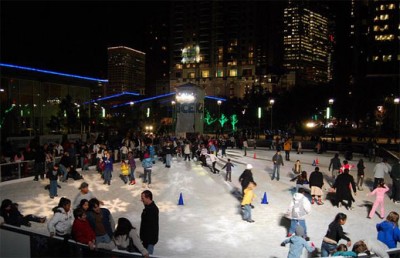Sense of community rises in down economy

It’s a fairly common phenomenon, when things are bad, people seek camaraderie. When things become difficult across an entire city or economy, people seek a sense of community.
So, how does that translate to our own cities and neighborhoods? A renewed, and perhaps, more authentic interest in contributing to both public gathering places and local venues, specifically third places. Not only that, but crowdsourcing is a natural community-building methodology for doing so. Project for Public Spaces, the leading resource for presenting public placemaking examples, contributed to a Urban Land Institute article, The Upside of a Down Economy, that provides several recent case studies of successful public gathering places.
Seattle third places – Ron Sher, CEO of Terranomics Development, redeveloped a retail complex around Third Place Books that anchors a gathering space hosting live music, festivals and a giant chess board. He also developed Third Place Commons, a common area filled with tables, a stage and performance area, restaurants and adjacent community college. The community formed a nonprofit just to run its events.
Restaurant-driven neighborhoods – Tony Goldman, CEO of Goldman Properties, has helped transform NYC’s Soho, Miami’s South Beach and Philadelphia’s Center City by sticking to his formula of investing in a minimum of 17 local restaurants (not chains), inviting local stakeholders to join in, as a means of establishing a meaningful sense of place and ownership.
Wildly popular public market – Granville Island, a public waterfront in Vancouver, British Columbia, Canada, attracts 10 million visitors per year to its 280 local businesses because of its distinct character as a diverse and comprehensive public gathering place. It’s secret? It’s long been organized as a public market based on local community groups, and remains the epitome of authenticity.
Detroit’s great hope – Read more about Campus Martius and it’s key role in the revitalization of Detroit in this previous blog post.
Houston’s Discovery Green – The City of Houston transformed 12 acres of downtown parking lots into a contemporary park with cafe, two restaurants, interactive fountain, playground, market promenade, dog runs, stage, sitting lawn and skating rink (pictured), attracting 250,000 visitors in less than three months and sparking investment in revitalization surrounding it.
Public market in Santiago, Chile – A public-private effort turned a desolate plaza adjacent to one of the city’s busiest transit hubs into SubCentro, a vibrant market and public space, soliciting the opinions of its residents from the beginning.
The growth of public markets in Barcelona, Spain – Rising prices in supermarkets have spurred a renewed interest in public markets, even encouraging private markets taking to the streets within a larger program to help revitalize neighborhoods.
Australia, New Zealand, and Singapore formed a coalition to invest in vibrant city centers, resulting in a Cultural Centre proposal in Perth, Australia as a model public gathering place, with photo exhibitions, indie music festivals, and a weekend market featuring local food producers.
Norway’s 13 ‘cities of the future’ is a formal program by the government to help 13 cities become models for sustainable development, of which preserving the cities’ almenninger (public spaces) is a major priority.
What stories are you familiar with?
Photo of ice rink in Discovery Green, Houston, Texas by Solburn.

This is some great news, thank you Neil.